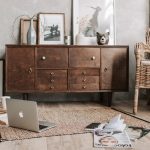You're ready to transform your home office into a productive workspace, but choosing the right small desk size is crucial.
With the myriad of options available, mastering the art of selecting the perfect desk size will enhance your efficiency and comfort.
By considering the dimensions of your available space, your storage requirements, and the ergonomic factors, you can optimize your workspace for maximum productivity.
This guide will help you navigate through the key considerations, from functionality to aesthetics, to ensure that you find the best small desk size for your home office.
Key Takeaways
- Assess and optimize available space by utilizing vertical space with built-in shelves or drawers and considering wall-mounted desks to free up floor space.
- Understand and maximize storage needs by identifying items that need to be readily accessible, categorizing supplies to determine storage solutions, and maximizing storage with built-in shelving, drawers, or vertical storage.
- Prioritize ergonomics and comfort by considering optimal desk height, ensuring enough space for movement, and investing in ergonomic designs for natural wrist and arm positions.
- Create a functional and aesthetic workspace by using adjustable lighting to minimize glare, maximizing storage space with built-in shelving or drawers, and balancing aesthetic appeal and practicality in desk selection.
Assessing Your Available Space
When setting up your home office, you should regularly assess the available space to determine the best small desk size for your needs. Maximizing functionality is crucial in a small office, so it's essential to make the most of every inch of space. One effective strategy for this is to utilize vertical space. Consider a small desk with built-in shelves or drawers to keep your work area tidy and organized while also maximizing storage. Additionally, wall-mounted desks can be a great way to free up floor space and create a more open and airy environment in your home office.
To make the most of your available space, take measurements and assess how much room you have to work with. This will help you determine the dimensions that will best fit your space without overwhelming it. Keep in mind that the best small desk size for your home office isn't only about fitting the physical dimensions but also about creating a workspace that promotes productivity and creativity.
Understanding Your Storage Needs
Assess your storage needs to determine how many drawers, shelves, or other storage options will best accommodate your office supplies and documents. Maximizing efficiency is key to maintaining a productive workspace. Organizing supplies in a way that minimizes clutter and maximizes space is essential for a small home office.
When evaluating your storage needs, consider the following:
- Frequency of Access: Identify items that need to be readily accessible versus those that can be stored out of the way.
- Types of Supplies: Categorize your supplies to determine the best storage solutions for different types of items, such as files, electronics, or stationery.
- Future Growth: Plan for potential expansion by choosing storage options that can adapt to your evolving needs.
Prioritizing Ergonomics and Comfort
You should prioritize ergonomics and comfort when choosing a small desk size for your home office.
Consider the optimal desk height to avoid straining your back and neck.
Also, make sure there's enough space for movement to prevent feeling cramped and uncomfortable during long work hours.
Optimal Desk Height
Choosing the right desk height is crucial for maintaining proper posture and comfort as you work in your home office. To ensure an optimal desk height, consider the following:
- Adjustable Options: Look for desks with adjustable heights, allowing you to customize the desk to your specific needs.
- Standing Desks: Consider using a standing desk, which promotes better posture and reduces the risks associated with prolonged sitting.
- Ergonomic Considerations: Prioritize desks with ergonomic designs that support natural wrist and arm positions, contributing to overall comfort and health.
Importance of Posture
To maintain good posture and prioritize ergonomics and comfort in your home office, it's essential to adjust your desk height and consider ergonomic design features. Proper alignment is crucial for preventing strain on your back, neck, and shoulders.
Look for desks with adjustable heights or consider using risers to customize the desk to your body's needs. Additionally, invest in a chair with adequate lumbar support to promote a healthy sitting posture.
Standing desks offer an alternative to sitting for prolonged periods and can help reduce the risk of musculoskeletal issues. If you prefer sitting, explore footrest options to support your feet and promote better posture.
Prioritizing ergonomics and comfort in your home office setup is essential for enhancing productivity and preventing long-term health issues.
Space for Movement
Consider placing your small desk in a location that allows for fluid movement and promotes ergonomic comfort. Movement flexibility is crucial for maintaining comfort and productivity in your home office, especially when dealing with space constraints. When considering workspace flow, take into account the room layout to ensure that your desk placement allows for easy navigation and accessibility.
Here are some key factors to consider:
- Ergonomic Design: Prioritize desks with adjustable heights or add-ons like keyboard trays to optimize comfort.
- Adequate Space: Ensure that there's enough room around the desk for you to move freely and access necessary items.
- Cable Management: Keep wires organized to prevent obstructions and maintain a clean, efficient workspace.
Factoring in Functional Design Elements
When choosing the best small desk size for your home office, you should consider the functional design elements that will enhance your productivity.
Think about how to create an ergonomic workspace setup to support your comfort and well-being while working.
Additionally, make use of storage space and select a desk that balances both aesthetic appeal and practicality.
Ergonomic Workspace Setup
You'll need an adjustable ergonomic chair for proper support and comfort in your home office. This is essential for maintaining good posture and reducing the risk of strain or injury.
Additionally, adjustable lighting is crucial to minimize glare and eye strain. Consider investing in task lighting that can be easily positioned to illuminate your workspace without causing discomfort.
- Ergonomic Chair: Look for a chair with adjustable height, lumbar support, and armrests to ensure proper posture and comfort.
- Adjustable Lighting: Invest in task lighting that can be easily positioned to reduce glare and eye strain.
- Workspace Organization: Keep frequently used items within arm's reach to minimize excessive stretching and reaching, promoting a more ergonomic workspace setup.
Storage Space Utilization
Maximize storage space in your small home office by utilizing functional design elements.
When it comes to maximizing space in a small home office, every inch counts. Look for desks with built-in shelving, drawers, or vertical storage to make the most of your limited space.
Wall-mounted shelves and pegboards are also great organization solutions for keeping your work area tidy and clutter-free. Consider multifunctional furniture pieces, such as a desk with a hutch or a filing cabinet that doubles as a side table.
Utilize vertical space by installing floating shelves or wall-mounted organizers. Additionally, invest in storage containers and organizers to keep small items in check.
Aesthetic and Practicality
To optimize your small home office for both aesthetics and practicality, consider incorporating functional design elements that maximize space and enhance efficiency. When selecting furniture and decor, aim for a balance between aesthetic appeal and space efficiency.
Here are some key design elements to consider:
- Multi-functional furniture: Invest in a desk with built-in storage or a wall-mounted desk to free up floor space.
- Vertical storage solutions: Utilize wall shelves, hanging organizers, and pegboards to keep essentials within reach while minimizing clutter.
- Strategic lighting: Use task lighting and ambient lighting to create a welcoming atmosphere while illuminating your workspace effectively.
Considering Multi-Use and Flexibility
When choosing a small desk size for your home office, prioritize multi-use and flexibility to make the most of your space. Multi-function furniture and space-saving solutions can significantly enhance the functionality of your home office. Consider investing in a desk that can serve as both a workspace and storage solution, such as a desk with built-in shelves or drawers. This will allow you to efficiently utilize the limited space without sacrificing essential storage. Additionally, opt for a desk with a versatile design that can adapt to different tasks. Look for features like foldable or extendable components that can create additional workspace when needed and be neatly tucked away when not in use. Here's a visual representation of the benefits of multi-use and flexible small desk options:
| Benefits of Multi-Use and Flexibility |
|---|
| Efficient use of limited space |
| Versatile design for different tasks |
| Integrated storage solutions |
| Adaptable workspace options |
Choosing a small desk size that prioritizes multi-use and flexibility is crucial for maximizing the functionality of your home office while optimizing space utilization.
Evaluating Aesthetic Preferences
Consider your aesthetic preferences when choosing a small desk size for your home office. Your home office should be a reflection of your personal style and taste, so it's essential to select a desk size that not only fits the practical needs of your workspace but also appeals to your aesthetic sensibilities.
When evaluating aesthetic preferences for your small desk size, keep in mind the following:
- Aesthetic Appeal: Take into account the overall look and feel of the desk. Consider the materials, color, and design elements that align with your personal style and complement the existing decor of your home office.
- Personal Style: Think about your individual preferences and the specific design elements that resonate with you. Whether you prefer a minimalist, modern, traditional, or eclectic style, your desk should reflect your unique aesthetic taste.
- Functionality and Aesthetics: Look for a balance between functionality and aesthetics. A desk that meets your practical needs while also enhancing the visual appeal of your workspace can contribute to a more inspiring and productive home office environment.
Considering these factors will help you choose a small desk size that not only serves its purpose but also adds to the overall aesthetic appeal of your home office.
Frequently Asked Questions
How Can I Incorporate a Small Desk Into a Shared Living Space Without It Feeling Out of Place?
You can incorporate a small desk into a shared living space by choosing a design that complements the existing decor and provides multi-functional use. Organize the desk with space-saving solutions to ensure it blends seamlessly.
Are There Any Small Desk Options That Can Easily Be Moved or Stored When Not in Use?
You can consider portable options or folding solutions for a small desk that can easily be moved or stored when not in use. Look for hidden storage and compact designs to maximize functionality in a shared living space.
What Are Some Space-Saving Storage Solutions for a Small Desk in a Home Office?
To maximize space, consider space-saving organization like wall-mounted shelves, under-desk storage, and compact desk solutions. Utilize vertical space with floating shelves and wall organizers for a clutter-free, efficient home office setup.
Can a Small Desk Still Accommodate Dual Monitors and Other Tech Accessories?
Yes, a small desk can accommodate dual monitors and tech accessories with space-saving monitor stands and cable management solutions. Consider a desk with built-in cable channels and drawers for organized storage.
Are There Any Small Desk Designs That Can Easily Transition From a Work Space to a Leisure or Creative Space?
For small desk versatility, consider compact desk designs that seamlessly transition from work to leisure. Look for multi-functional features like built-in storage, adjustable heights, and convertible surfaces to maximize your space and productivity.





